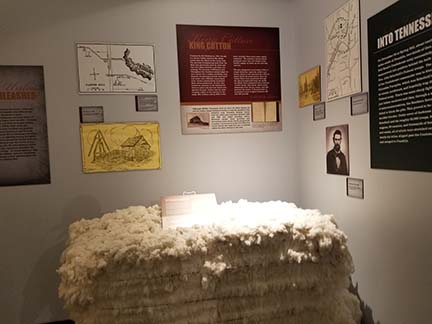By Monique Gooch
FRANKLIN, TN — The Battle of Franklin was fought on Nov. 30, 1864 as part of the Tennessee Campaign of the American Civil War. It was one of the worst disasters of the war for the Confederate States Army.
The Carter House, which stands today and is open to visitors, was located at the center of the Federal Army’s position. And it was surrounded by some of the worst hand to hand combat of the war. The surviving buildings are a testament to the skill of the enslaved carpenters and masons who built them.
One can still run their hands along the hand-hewn boards in the cellar, boards carved with an axe. Fountain B. Carter, a shoemaker, and Polly Atkinson married in Franklin in 1823. The couple had 12 children.
In 1830, the Carter family owned eight slaves and Fountain purchased 19 acres on the edge of Franklin. The production on the farm consisted of livestock and grain until 1850, when Fountain built a cotton gin on the property. The Carter enslaved people produced nearly 500 bushels of wheat and oats and 12,000 pounds of cotton. The farm grew exponentially each year through 1860.
And on Nov. 30, the lives of everyone on the Carter farm were indelibly changed. The Battle of Franklin was fought in

Carter’s yard, consuming the farm in violence. During the long night of the battle the family, the enslaved people and neighbors huddled together in the cellar as a storm of war raged outside their windows. Jack, Calfurnia, John, Susie, Tom, Oscar and Gus were among the enslaved men, women and children in the cellar that night.
The individuals in the cellar had very different realities and their futures were all bound for a different path, but that night they all huddled together praying for survival.
The seven slave cabins at the Carter House did not survive the fighting. The property currently has one slave cabin that was brought on the property in the 20th century from about another location in Williamson County. It is representative of the average slave cabin for the region.
During the Carter tour, visitors are allowed to take pictures outside, but not inside certain places due to the frail condition of some of the structures. The Battle of Franklin tour lasts an hour and afterward visitors are allowed to roam the grounds and take pictures. Inside the Carter House everything is original, from beds, furniture to family pictures. The parlor room is full of bullet holes from the battle.
When asked why this a place African Americans should visit, the tour guide Kristi said, “this place tells a story from every point of view. It tells the human perspective. We try to cover everything in one hour, from the battle, to the Carter House, the enslaved people, politics, etc. If we don’t have different people coming to visit, people are missing out on human stories.”
There is also a tour that discusses slavery and goes into deeper details about the enslaved people who lived there. Those tours are separate and are 90 minutes long. “If people just want to learn about the Battle of Franklin, we have that. If people just want to learn about slavery, we offer that too. But this tour offers both, and we try to get everything into one hour. And I think this tour does a great job of discussing both,” Kristi said.
Tours are offered Monday through Saturday from 9am to 5pm, and Sunday from 11am to 5pm tickets can be purchased at the site or at www.boft.org.
Kristi ended with, “I believe everything that has happened since the Civil War has happened because of the Civil War. For a long time learning about the Civil War became about dressing up and re-enacting battles and it became a very ‘White’ subject. The Civil War is an important event in American History. It impacted all Americans. The most obvious impact was at the end of the war. Freedom was given to almost four million Americans and 720,000 Americans died as a result of the fighting. The impact of the Civil War can still be felt reverberating through our country. Everything that has happened since, is a direct result of those four years and the people impacted by it.”



